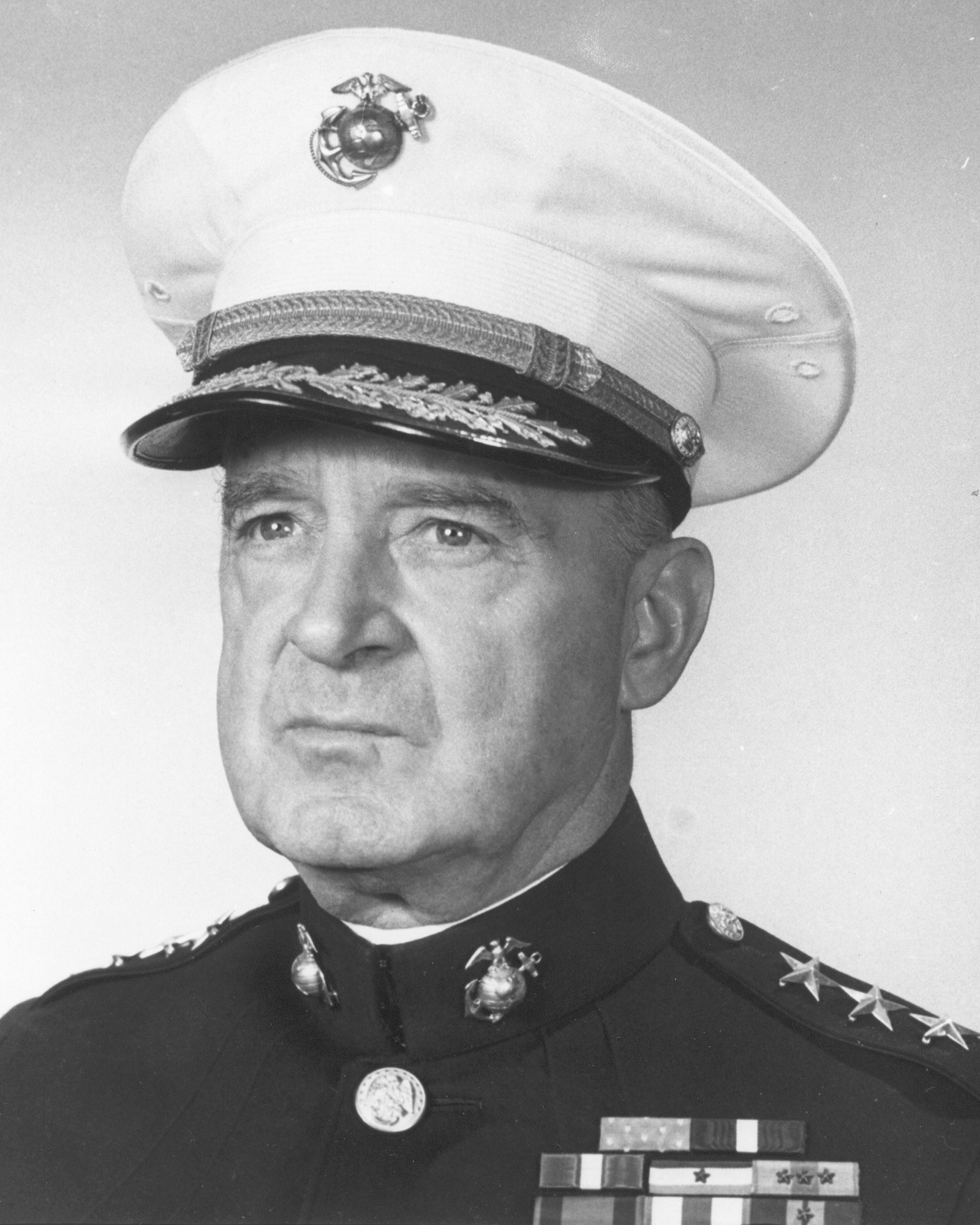
GENERAL
ALEXANDER ARCHER VANDEGRIFT, USMC (DECEASED)
Medal of Honor Citation
General Alexander Archer Vandegrift, World War II Medal of Honor recipient and 18th Commandant of the Marine Corps, was born on 13 March 1887 in Charlottesville, Virginia. He attended the University of Virginia and was commissioned in the Marine Corps as a second lieutenant on 22 January 1909.
Following instruction at the Marine Officers' School, Port Royal, South Carolina, and a tour of duty at the Marine Barracks, Portsmouth, New Hampshire, he went to foreign shore duty in the Caribbean area. He participated in the bombardment, assault, and capture of Coyotepe in Nicaragua. He further participated in the engagement and occupation of Vera Cruz, Mexico.
In December 1914, following his promotion to first lieutenant, he attended the Advance Base Course at the Marine Barracks, Philadelphia. Upon completion of schooling, he sailed for Haiti with the 1st Brigade and participated in action against hostile Cacos bandits at LeTrou and Fort Capois. In August 1916, he was promoted to captain and became a member of the Haitian Constabulary at Port Au Prince, where he remained until detached to the United States in December 1918. He returned to Haiti again in July 1919 to serve with the Gendarmerie d'Haiti as an Inspector of Constabulary. He was promoted to major in June 1920.
Major Vandegrift returned to the U.S. in April 1923 and was assigned to the Marine Barracks, Quantico, Virginia. He completed the Field Officers' Course, Marine Corps Schools in May 1926. He then was transferred to the Marine Corps Base, San Diego, California, as Assistant Chief of Staff.
In February 1927, he sailed for China where he served as Operations and Training Officer of the 3d Marine Brigade with Headquarters at Tientsin. He was ordered to Washington, D.C., in September 1928 where he became Assistant Chief Coordinator, Bureau of the Budget.
Following duty in Washington, he joined the Marine Barracks, Quantico, where he became Assistant Chief of Staff, G-1 Section, Fleet Marine Force (FMF). During this assignment, he was promoted to lieutenant colonel in June 1934.
Ordered to China in June 1935, LtCol Vandegrift served successively as Executive Officer and Commanding Officer of the Marine Detachment at the American Embassy in Peiping. Promoted to colonel in September 1936, Col Vandegrift reported to Headquarters Marine Corps (HQMC), Washington, D.C. in June 1937, where he became Military Secretary to the Major General Commandant. In March 1940, he was appointed Assistant to the Major General Commandant, and the following month was promoted to brigadier general.
Brigadier General Vandegrift was detached to the 1st Marine Division in November 1941, shortly before the outbreak of World War II. He was promoted to major general in March 1942 and sailed for the South Pacific Area that May as commanding general of the first Marine division to ever leave the shores of the United States. On 7 August 1942, in the Solomon Islands, he led ashore the 1st Marine Division in the first large-scale offensive action against the Japanese. For outstanding service as Commanding General of the 1st Marine Division during the attack on Guadalcanal, Tulagi, and Gavutu in the Solomon Islands, he was awarded the Navy Cross and for the subsequent occupation and defense from 7 August to 9 December 1942, was awarded the Medal of Honor.
In July 1943, he assumed command of the I Marine Amphibious Corps and commanded this organization in the landing at Empress Augusta Bay, Bougainville, Northern Solomon Islands, on 1 November 1943. Upon establishing the initial beachhead, he relinquished command and returned to Washington, D.C. as Commandant-designate.
On 1 January 1944, as a lieutenant general, he was sworn in as the 18th Commandant of the Marine Corps. On 4 April 1945, he was appointed general, with date of rank from 21 March 1945, the first Marine officer on active duty to attain four-star rank. For outstanding service as Commandant of the Marine Corps from 1 January 1944 to 30 June 1946, Gen Vandergrift was awarded the Distinguished Service Medal. He left active service on 31 December 1947 and was placed on the retired list 1 April 1949.
General Vandegrift died 8 May 1973 at the National Naval Medical Center, Bethesda, Maryland, after a long illness. He was 86. His interment was 10 May 1973 at Arlington National Cemetery.
General Vandegrift held an honorary degree of Doctor of Military Science from Pennsylvania Military College, and honorary degrees of Doctor of Law from Harvard, Colgate, Brown, Columbia, and Maryland Universities and John Marshall College.
In addition to the Medal of Honor, Navy Cross, and Distinguished Service Medal, his decorations and medals included: the Presidential Unit Citation with one bronze star; Navy Unit Commendation with one bronze star; Expeditionary Medal with three bronze stars; Nicaraguan Campaign Medal; Mexican Service Medal; Haitian Campaign Medal with one star; World War I Victory Medal with West Indies Clasp and one star; Yangtze Service Medal; American Defense Service Medal; Asiatic-Pacific Campaign Medal with four bronze stars; American Campaign Medal; and the World War II Victory Medal.
He received the following foreign decorations: Haitian Distinguished Service Medal; Medaille Militaire with one silver star; Honorary Knight Commander, Military Division of the Most Excellent Order of the British Empire; Companion (Honorary) of the Military Division of the Most Honorable Order of the Bath; Cruz de Aviacion de Primera Clase, Peruvian Government; Abdon Calderon of the 1st Class; Knights Grand Cross in the Order of the Orange-Nassau with Swords; the Order of Pao-Tine (Precious Tripod) with Special Clasp; and the Legion of Honor (Grand Officer).
Commandants of the Marine Corps
Documents, Orders and Speeches
World War II 1941-1945 Medal of Honor